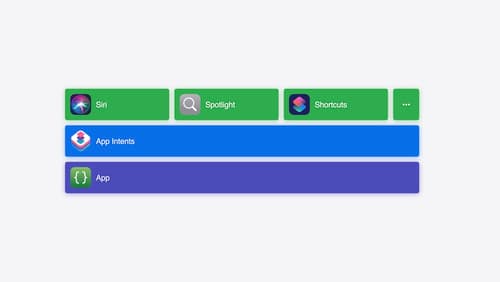how can I integrate app intents to my app
Asked on 2024-08-02
1 search
To integrate App Intents into your app, you can follow these steps based on the sessions from WWDC:
-
Understand the Framework:
- App Intents is a framework that allows you to expose your app's core features in a way that the system can understand. This enables features like Siri, Spotlight, and Shortcuts to present your app's actions and content outside of the app.
- Bring your app’s core features to users with App Intents
-
Designing App Intents:
- Start by identifying the core actions and content in your app that are meaningful to users. These should be tasks that users might want to perform even when they are not directly in your app.
- App Intents should be designed to be flexible and readable across many configurations and use cases. Avoid creating multiple intents for the same task; instead, use parameters to make a single intent more versatile.
- Design App Intents for system experiences
-
Structuring App Intents:
- Structure your app intents to be clear and concise. Each intent should have a summary that includes the app name, a verb, and the necessary parameters.
- Ensure that the parameter summaries are readable as sentences, which helps users understand what the intent does when exploring in the Shortcuts drawer.
- Design App Intents for system experiences
-
Implementing App Intents:
- Use the App Intents framework to define your app's core actions and content. This involves creating intents that represent these actions and making them available to system features like Siri and Shortcuts.
- Bring your app’s core features to users with App Intents
-
Testing and Refining:
- Test your app intents to ensure they work seamlessly across different system features. Make sure they are flexible and can handle various configurations and use cases.
- Provide options for users to toggle certain behaviors, such as opening the app when an intent is run, to enhance the user experience.
- Design App Intents for system experiences
By following these steps, you can effectively integrate App Intents into your app, making it more accessible and useful to users even when they are not directly interacting with it. For more detailed guidance, you can refer to the sessions mentioned above.

Bring your app’s core features to users with App Intents
Learn the principles of the App Intents framework, like intents, entities, and queries, and how you can harness them to expose your app’s most important functionality right where people need it most. Find out how to build deep integration between your app and the many system features built on top of App Intents, including Siri, controls and widgets, Apple Pencil, Shortcuts, the Action button, and more. Get tips on how to build your App Intents integrations efficiently to create the best experiences in every surface while still sharing code and core functionality.

Design App Intents for system experiences
App Intents power system experiences in controls, Spotlight, Siri, and more. Find out how to identify the functionality that’s best for App Intents, and how to use parameters to make these intents flexible. Learn how to use App Intents to allow people to take action outside your app, and see examples of when to navigate into your app to show contextual information.
